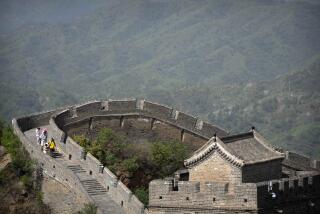Mayas mastered rubber long before Goodyear
- Share via
Hundreds and perhaps even thousands of years before Charles Goodyear discovered the vulcanization process that made commercial rubber viable, Mesoamerican peoples were carrying out a similar process to produce rubber artifacts for a broad variety of uses, two MIT researchers have found.
By varying the amount of materials they added to raw rubber, Mesoamericans were able to produce bouncy rubber balls for the Mayas’ ceremonial games, resilient rubber sandals and sticky material used to glue implements to handles, the research shows.
The researchers “have compiled a compelling case that ancient Mesoamerican peoples were the first polymer scientists, exerting substantial control over the mechanical properties of rubber for various applications,” said materials scientist John McCloy of the Pacific Northwest National Laboratory, who was not involved in the research.
Ancient rubber footwear has not been found at archaeological sites, but written records of the Spanish conquistadores indicate that the indigenous peoples wore them. Archaeologists have found rubber balls, bands, statues and adhesives.
Rubber is a latex material produced from the sap of a variety of trees. Mesoamericans got it from what is now known as the Panama rubber tree, Castilla elastica. But the rubber produced as the sap dries is sticky and, ultimately, brittle.
The current research derives from a simple question asked by then-MIT-undergraduate Michael J. Tarkanian in a freshman archaeology class in 1996: How did the Maya produce bouncy rubber balls from this material?
Intrigued, the course’s teacher, materials scientist Dorothy Hosler, did some quick research and “a few days later, she e-mailed me and said no one has ever answered the question,” Tarkanian said in a telephone interview.
That kicked off what has so far been a 14-year collaboration between the two scientists.
Thorough study of written records of the Spanish conquerors indicated that the Maya made their balls by mixing the latex with juice from the morning glory, Ipomoea alba, a vine that grows throughout the region. In 1999, Hosler and Tarkanian reported that they could make bouncy rubber balls by mixing equal amounts of latex and morning glory juice and heating them.
“But doing the work, I noticed that different ratios [of the two ingredients] produced different properties,” Tarkanian said.
Ultimately, as they will report in a forthcoming issue of the journal Latin American Antiquity, they found different formulas that provided different characteristics. A 50-50 mixture produced a bouncy rubber ball, for example, while adding one part morning glory to three parts latex produced a strong, durable material suitable for sandals.
Adding no morning glory produces a material that is a good adhesive. In the paper, they characterize for the first time the physical and chemical properties of each form.
The oldest known rubber balls from the region date to 1600 BC, suggesting that the indigenous peoples possessed this knowledge at least that far back. By the time the Spaniards arrived in the 16th century, Tarkanian said, “there was a large rubber industry in the region,” producing 16,000 rubber balls each year and large numbers of rubber statues, sandals, bands and other products.
Most of these were produced in outlying areas and shipped to Tikal, the Maya capital, as tax payments.
Around 1839, American inventor Charles Goodyear came up with the vulcanization process, in which latex from the Brazilian rubber tree is heated with sulfur. The sulfur causes the polymer chains of the latex to become cross-linked, making them stronger, more durable and more elastic.
The morning glory juice has sulfur-containing amino acids that apparently do much the same thing, Tarkanian said. The density of cross-links is much greater in the vulcanized rubber, however.
Tarkanian and Hosler have not yet identified a unique chemical signature of their lab-produced material that can be compared directly to archaeological samples — a process that is complicated by the tendency of rubbers to deteriorate over long periods. But they have noted that certain proteins in the raw latex are removed during their manufacturing process. Analysis of some ancient artifacts indicates the same proteins are missing there as well.
Archaeologist Frances Berdan of CSU San Bernardino said in a statement that the work has implications well beyond rubber. “There are other areas of production where the pre-Hispanic peoples cleverly combined materials to achieve enhanced products,” she said.
The MIT work should encourage researchers to investigate these other areas as well, she said.






